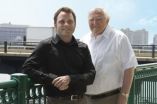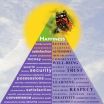(Press-News.org) In 2009, the American Society of Civil Engineers (ASCE) assigned the grade "D" to the overall quality of infrastructure in the U.S. and said that ongoing evaluation and maintenance of structures was one of five key areas necessary for improving that grade. Since that time, federal stimulus funds have made it possible for communities to repair some infrastructure, but the field of high-tech, affordable methods for the continual monitoring of structures remains in its infancy. Instead, most evaluation of bridges, dams, schools and other structures is still done by visual inspection, which is slow, expensive, cumbersome and in some cases, dangerous.
Civil engineers at MIT working with physicists at the University of Potsdam in Germany recently proposed a new method for the electronic, continual monitoring of structures. In papers appearing in the Journal of Structural Control (December 2010) and the Journal of Materials Chemistry (April 2011) the researchers describe how a flexible skin-like fabric with electrical properties could be adhered to areas of structures where cracks are likely to appear, such as the underside of a bridge, and detect cracks when they occur.
Installing this "sensing skin" would be as simple as gluing it to the surface of a structure in the length and width required. The rectangular patches in the skin could be prepared in a matrix appropriate for detecting the type of crack likely to form in a particular part of a structure. A sensing skin formed of diagonal square patches (3.25 inches by 3.25 inches, for instance) would be best at detecting cracks caused by shear, the movement in different directions of stacked layers. Horizontal patches would best detect the cracks caused when a horizontal beam sags. The largest patch tested using the prototype reached up to 8 inches by 4 inches in size.
The formation of a crack would cause a tiny movement in the concrete under the patch, which would cause a change in the capacitance (the energy it is storing) of the sensing skin. Once daily, a computer system attached to the sensing skin would send a current to measure the capacitance of each patch and detect any difference among neighboring patches. In this way, it would detect the flaw within 24 hours and know its exact location, a task that has proved difficult for other types of sensors proposed or already in use, which tend to rely on detecting global changes in the entire structure using a few strategically placed sensors.
"The sensing skin has the remarkable advantage of being able to both sense a change in the general performance of the structure and also know the damage location at a pre-defined level of precision," said Simon Laflamme Ph.D. '11, who did this research as a graduate student in the MIT Department of Civil and Environmental Engineering (CEE). "Such automation in the health monitoring process could result in great cost savings and more sustainable infrastructures, as their lifespan would be significantly increased as a result of timely repairs and reduced number of inspections." Laflamme, worked with Professor Jerome Connor of MIT CEE and University of Potsdam researcher Guggi Kofod and graduate student Matthias Kollosche.
The researchers originally tested their idea using a commercially available, inexpensive stretchy silicon fabric with silver electrodes. While this worked in some of the lab experiments performed on both small and large concrete beams under stress, the material showed limitations in its installation because it was too thin and flexible for this use. The researchers have now developed a prototype of a sensing skin made of soft stretchy thermoplastic elastomer mixed with titanium dioxide that is highly sensitive to cracks, with painted patches of black carbon that measure the change in the electrical charge of the skin. A patent for the sensing method was filed in March 2010.
"Many of the types of infrastructures graded by the ASCE are made of concrete and could benefit from a new monitoring system like the sensing skin, including bridges which received a C grade, and dams and schools, which earned Ds," said Connor. "The safety of civil infrastructures would be greatly improved by having more detailed real-time information on structural health."
INFORMATION:
'Sensing skin' could monitor the health of concrete infrastructure continually and inexpensively
New type of sensor could immediately detect tiny cracks in structures and relay their exact location
2011-06-30
ELSE PRESS RELEASES FROM THIS DATE:
Tripping the fluid dynamic: The physics of Jackson Pollock
2011-06-30
CHESTNUT HILL, MA (June 29, 2011) – American artist Jackson Pollock's paintings often clashed with the rules of the art world. But they couldn't defy the laws of physics, according to a multidisciplinary team of researchers from Boston College and Harvard who give quantitative form to Pollock's methods and genius in the latest edition of the journal Physics Today.
Quantitative analysis is a phrase few would associate with Pollock, the abstract expressionist who during the 1940s and 50s adopted the method of pouring paint onto canvas in order to convey his artistic vision ...
Researchers look for ingredients of happiness around the world
2011-06-30
CHAMPAIGN, Ill. — In 1943, American psychologist Abraham Maslow proposed that all humans seek to fulfill a hierarchy of needs, which he represented with a pyramid. The pyramid's base, which he believed must come first, signified basic needs (for food, sleep and sex, for example). Safety and security came next, in Maslow's view, then love and belonging, then esteem and, finally, at the pyramid's peak, a quality he called
"self-actualization." Maslow wrote that people who have these needs fulfilled should be happier than those who don't.
In a new study, researchers at ...
Georgia residents: Investment in global health research is vital to state's economy
2011-06-30
WASHINGTON—June 29, 2011—Nearly three-quarters (74%) of Georgia residents think spending money on research to improve health globally is important for economic development in Georgia, according to a new statewide poll commissioned by Research!America.
Eighty-one percent say global health is an issue about which Georgia residents should be concerned, and Georgians place a very high value on their state's leadership in research to improve health here and around the world: 96% say it is important for Georgia to be a leader in health research and development, and 81% say ...
New fossils demonstrate that powerful eyes evolved in a twinkling
2011-06-30
Palaeontologists have uncovered half-a-billion-year-old fossils demonstrating that primitive animals had excellent vision.
An international team led by scientists from the South Australian Museum and the University of Adelaide found the exquisite fossils, which look like squashed eyes from a recently swatted fly.
This discovery will be published tomorrow (Thursday 30 June 2011) in the prestigious journal Nature.
The lead author is Associate Professor Michael Lee from the South Australian Museum and the University of Adelaide's School of Earth & Environmental Sciences.
Compound ...
A war inside: Saving veterans from suicide
2011-06-30
PHILADELPHIA - An estimated 18 American military veterans take their own lives every day -- thousands each year -- and those numbers are steadily increasing. Even after weathering the stresses of military life and the terrors of combat, these soldiers find themselves overwhelmed by the transition back into civilian life. Many have already survived one suicide attempt, but never received the extra help and support they needed, with tragic results. A team of researchers from the Perelman School of Medicine at the University of Pennsylvania and colleagues found that veterans ...
IOM report calls for cultural transformation of attitudes toward pain and its prevention and management
2011-06-30
WASHINGTON — Every year, at least 116 million adult Americans experience chronic pain, a condition that costs the nation between $560 billion and $635 billion annually, says a new report from the Institute of Medicine. Much of this pain is preventable or could be better managed, added the committee that wrote the report.
The committee called for coordinated, national efforts of public and private organizations to create a cultural transformation in how the nation understands and approaches pain management and prevention. Some of the recommended changes can be implemented ...
NASA/NOAA GOES-13 satellite movie shows how Tropical Storm Arlene formed
2011-06-30
Have you ever seen a low pressure area develop into a full-fledged tropical storm? The GOES-13 satellite has and now you can see it in a new animation released today from NASA and NOAA.
System 95L strengthened and became the Atlantic Ocean hurricane season's first tropical storm, named Arlene. It happened at 8 p.m. EDT on June 27 in the southwestern Gulf of Mexico, and the GOES-13 satellite caught the storm coming together.
The Geostationary Operational Environmental Satellite called GOES-13 provides continuous visible and infrared imagery of the eastern U.S. and Atlantic ...
Diabetes drug may prevent or delay development of polycystic ovary syndrome
2011-06-30
Chevy Chase, MD— A recent study accepted for publication in The Endocrine Society's Journal of Clinical Endocrinology & Metabolism (JCEM) found that early, prolonged treatment with the diabetes drug metformin may prevent or delay the development of polycystic ovary syndrome (PCOS) in adolescence.
PCOS affects 7 to 10 percent of women of childbearing age and is the most common cause of infertility, affecting an estimated 5 to 6 million women in the United States, according to The Hormone Foundation.
"PCOS often presents in adolescence, with irregular menstrual cycles, ...
Astronomers discover universe's most distant quasar
2011-06-30
A scientist at The University of Nottingham is part of a team of astronomers which has discovered the most distant quasar to date — a development that could help further our understanding of a universe still in its infancy following the Big Bang.
This brilliant and rare beacon, powered by a black hole with a mass two billion times that of the Sun, is by far the brightest object yet found from a time when the Universe was less than 800 million years old — just a fraction of its current age.
The object that has been found, named ULAS J1120+0641, is around 100 million years ...
Men play post-op catch-up
2011-06-30
Although women generally have worse knee function and more severe symptoms before undergoing surgery for knee replacement than men, they recover faster after the operation. Men take longer to recover but, after a year, they catch up with women and there are no differences in surgery outcomes at that time. These findings by Thoralf Liebs, from Hassenpflug University of the Schleswig-Holstein Medical Center in Germany, and colleagues, are published online in Springer's journal Clinical Orthopaedics and Related Research.
Although research to date shows conflicting results, ...
LAST 30 PRESS RELEASES:
Fame itself may be critical factor in shortening singers’ lives
Daily coffee drinking may slow biological ageing of people with major mental illness
New highly efficient material turns motion into power – without toxic lead
The DEVILS in the details: New research reveals how the cosmic landscape impacts the galaxy lifecycle
After nearly 100 years, scientists may have detected dark matter
Gender imbalance hinders equitable environmental governance, say UN scientists
Six University of Tennessee faculty among world’s most highly cited researchers
A type of immune cell could hold a key to preventing scar tissue buildup in wounds
Mountains as water towers: New research highlights warming differences between high and low elevations
University of Tennessee secures $1 million NSF grant to build semiconductor workforce pipeline
Biochar shows powerful potential to build cleaner and more sustainable cities worldwide
UT Health San Antonio leads $4 million study on glucagon hormone’s role in diabetes, obesity
65-year-old framework challenged by modern research
AI tool helps visually impaired users ‘feel’ where objects are in real time
Collaborating minds think alike, processing information in similar ways in a shared task
Routine first trimester ultrasounds lead to earlier detection of fetal anomalies
Royal recognition for university’s dementia work
It’s a bird, it’s a drone, it’s both: AI tech monitors turkey behavior
Bormioli Luigi renews LionGlass deal with Penn State after successful trial run
Are developers prepared to control super-intelligent AI?
A step toward practical photonic quantum neural networks
Study identifies target for disease hyper progression after immunotherapy in kidney cancer
Concordia researchers identify key marker linking coronary artery disease to cognitive decline
HER2-targeted therapy shows promising results in rare bile duct cancers
Metabolic roots of memory loss
Clinical outcomes and in-hospital mortality rate following heart valve replacements at a tertiary-care hospital
Too sick to socialize: How the brain and immune system promote staying in bed
Seal milk more refined than breast milk
Veterans with cardiometabolic conditions face significant risk of dying during extreme heat events
How plants search for nutrients
[Press-News.org] 'Sensing skin' could monitor the health of concrete infrastructure continually and inexpensivelyNew type of sensor could immediately detect tiny cracks in structures and relay their exact location



